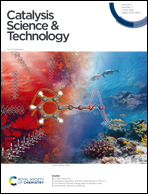Metalloporphyrin immobilized CeO2: in situ generation of active sites and synergistic promotion of photocatalytic water oxidation†
Abstract
Inhibiting photo-generated charge recombination on molecular catalysts (MCs) and accelerating reaction kinetics on semiconductor catalysts are desired for promoting photocatalytic water oxidation. Coupling MCs with semiconductors to mimic natural photosynthetic systems may provide a smart strategy to simultaneously achieve the above targets. However, the lack of understanding for the interface interaction between the MCs and the semiconductors remains a key challenge to unlock the photocatalytic performance. Herein, we coupled two nonprecious-metal catalysts, cobalt porphyrin (CoTCPP) and cerium oxide (CeO2 nanotubes), that are well matched in energy levels, to form CoTCPP@CeO2 composites by facile solution synthesis. The interface interaction was systematically evaluated in terms of charge transfer and surface catalytic reaction. It was found that CoTCPP acts initially as a charge transporter to transfer photoexcited electrons to CeO2 by d–f electron coupling, which effectively suppresses the charge recombination. Furthermore, the interfacial charge transfer results in reduction on CeO2 accompanied with the creation of oxygen vacancies (OVs) and oxidation on CoTCPP that transforms into CoOOH. The in situ generated OVs and CoOOH species both act as the active sites to synergistically accomplish the photocatalytic water oxidation, thereby resulting in significantly boosted oxygen evolution reaction (OER) performance and long-term stability in neutral or even acidic environments. The CoTCPP@CeO2NTs with an optimized composition ratio exhibit superior catalytic water oxidation characteristics in a neutral environment triggered by light, including a high oxygen production of 30 μmol g−1 h−1 and ultralong durability, which highly prevail over the performance of analogous systems such as H2TCPP@CeO2 NTs, Co3O4@CeO2 NTs and TCPP@Co3O4@CeO2 NTs under the same conditions. These findings disclosed the interfacial interactions between the heterogeneous components in terms of charge transfer and surface catalytically active sites, demonstrated the necessity of d–f electron coupling for effective charge transfer to inhibit charge recombination, and provided a smart strategy that highlights the in situ generation of catalytically active species, for instance, the OVs and oxyhydroxide, for promoting the photocatalytic OER and improving the catalytic durability.



 Please wait while we load your content...
Please wait while we load your content...